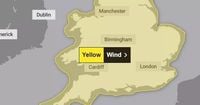The United Kingdom is bracing itself for a powerful blast of early autumn weather, as the Met Office has dramatically expanded its yellow weather warning for extreme wind to cover nearly the entire nation. What began as a localized alert for select coastal and southern regions has, in a matter of days, transformed into a 22-hour warning spanning most of England and Wales, with significant portions of Scotland and Northern Ireland also on watch. The warning, effective from 8pm on Sunday, September 14, 2025, until 6pm on Monday, September 15, 2025, is expected to bring strong and gusty winds, heavy rain, and widespread disruption to daily life.
According to the Met Office, gusts of 45 to 55 mph are anticipated across much of the country, with the potential for winds as high as 70 mph in exposed coastal and hilltop locations. In some particularly vulnerable spots, forecasters have even warned of gusts reaching up to 80 mph. The risk is not merely theoretical: “There is a small risk the winds could cause flying debris that could cause serious injury or death,” the Met Office cautioned in its latest update, as reported by Surrey Live.
The yellow warning initially covered just parts of Surrey, such as Haslemere, Godalming, Dorking, and Reigate. However, by Friday, September 12, the Met Office expanded the alert to include the entire county, encompassing Guildford, Woking, Epsom, Sutton, and all surrounding areas, as well as regions from Merseyside and Greater Manchester to Yorkshire, the Midlands, and nearly all of Wales. The warning now stretches across a vast swath of the UK, affecting millions of people in both rural and urban communities.
Travel disruption is expected to be widespread, with delays anticipated on road, rail, air, and ferry networks. The Met Office has warned that high-sided vehicles could face particular challenges on exposed routes and bridges. Large waves and sea spray are forecast to batter coastal communities, prompting authorities to advise pedestrians and dog walkers to avoid cliff edges and keep pets on leads. “Some delays to road, rail, air and ferry transport are likely. It’s likely that some coastal routes, sea fronts and coastal communities will be affected by spray and/or large waves,” the Met Office stated, as cited by Liverpool Echo.
Power cuts are another concern, with the possibility of short-term outages as strong winds bring down trees and power lines. The public is being urged to prepare by securing loose items in gardens and having torches and batteries ready. “We urge anyone setting out to reduce their speeds while driving and pass high-sided vehicles with particular care,” advised Rod Dennis, spokesperson for the RAC breakdown service, in The Independent. The RAC also recommended that drivers consider delaying journeys or seeking alternative routes, especially across exposed roads like those over the moors in Devon and Cornwall.
The meteorological picture is further complicated by a period of unsettled weather preceding the main wind event. Saturday, September 13, is forecast to bring sunny spells and scattered, sometimes thundery, showers across the UK, with chilly nights and possible grass frosts in the far north and Scottish glens. As the low-pressure system deepens over the North Atlantic, the worst of the wind is expected to build up along the southwest coasts of England and Wales on Sunday evening before sweeping inland overnight and peaking across central and southern regions by Monday morning.
Despite the blustery conditions, temperatures are forecast to remain relatively warm for mid-September. In Surrey, highs of 20°C are expected on both Sunday and Monday, while Liverpool could see temperatures reaching 18°C. However, heavy rain is also likely to accompany the winds, particularly on Sunday, with a 70% chance of downpours from noon in some areas, according to the Liverpool Echo. The Met Office predicts that the bulk of the rain will fall during the warning period, with drier but not particularly sunny weather returning from Tuesday, September 16, through Thursday, September 18, and temperatures hovering around 19°C.
For those wondering whether this weather system will be officially named as a storm, the answer is no—at least for now. “There is no intention to name it, as of now,” Met Office spokesperson Grahame Madge told The Independent on Friday morning. Chief Meteorologist Paul Gundersen echoed this sentiment, stating, “At present, a named storm is unlikely.” Both meteorologists emphasized that while the weather is impactful, it is not considered unusual for this time of year. “Obviously, we are in meteorological autumn now, it’s the sort of weather that we do expect at this time of year. So it’s nothing unusual, particularly – perhaps it’s just the contrast with the weather that we have enjoyed over most of the summer,” Madge explained.
Still, the scale of the warning is significant. The Met Office’s list of affected areas reads like a roll call of British geography: East Midlands, East of England, London & South East, North East England, North West England, South West England, Wales, West Midlands, and Yorkshire & Humber. Cities and towns from Derby and Leicester to Brighton, Manchester, Liverpool, Cardiff, and Leeds are all in the warning zone. The breadth of the alert reflects the deepening low-pressure system’s reach and the Met Office’s caution in the face of potential disruption.
Looking ahead, forecasters say the winds will begin to ease from the west on Monday afternoon, offering a brief respite on Tuesday. However, another weather system is already developing in the Atlantic, with the potential to bring severe gales to exposed coastal locations on Wednesday, September 17. “This will have less of an impact than Sunday and Monday’s weather front and it is too early to tell where it will impact,” Madge noted.
The Met Office’s advice for the public is straightforward but important: secure loose outdoor items, check travel conditions before setting out, and be prepared for possible power cuts. Those living or traveling near the coast should exercise extra caution, especially in areas prone to large waves and sea spray. For drivers, the message is clear—slow down, be vigilant, and avoid exposed routes if possible.
As the UK prepares for this burst of autumnal weather, communities are reminded that while such storms are not uncommon, their impact can be mitigated through preparation and caution. Whether it’s a blustery walk in the park, a delayed train, or a power outage at home, the next few days promise to test the nation’s resilience—and perhaps, its patience as well.


